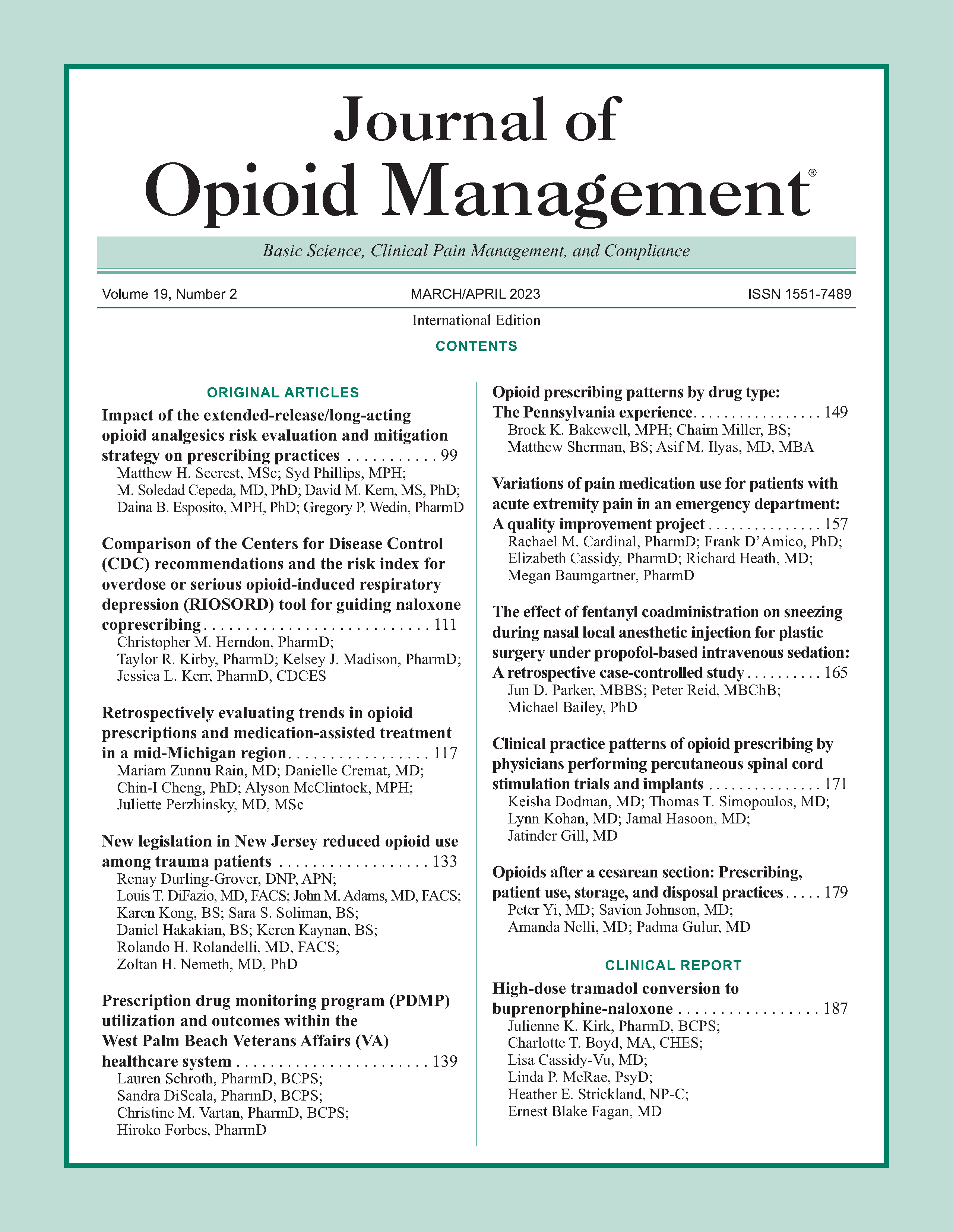Opioids after a cesarean section: Prescribing, patient use, storage, and disposal practices
DOI:
https://doi.org/10.5055/jom.2023.0773Keywords:
cesarean section, opioids, post-operative pain, opioid use, opioid storage, opioid disposal, opioid prescribing, post-operative opioidsAbstract
Cesarean sections (C-sections) are commonly performed procedures, accounting for approximately one-third of births in the United States. This is often one of the first medical encounters for women which require prescription medications to manage post-operative pain. Our observational study looked at opioids prescribed and consumed for post-surgical C-section pain. We interviewed patients to examine handling practices of those who had excess opioids, including storage and disposal. Patients underwent a C-section at Duke University Health System from January 2017 through July 2018 and were prescribed opioids post-operatively. In this study, we observed 154 women who met inclusion criteria. Sixty women declined participation, and 15 could not recall the details of their opioid use. Of the 77 women who participated, most (97 percent) received oxycodone 5 mg tablets. About one-third of the women did not use any opioids, about one-third used all of their opioids, and the remainder used only a fraction of the pills prescribed. After sharing preliminary results with providers, they began prescribing fewer pills. Even then, only a fraction or none of the pills were used, and patients rarely required a renewal of pain prescriptions. We found only 1 percent of women stored their opioids in a secure location. These findings suggest an individualized approach to opioid prescribing along with nonopioid analgesics use may mitigate the consequences of excess opioid prescribing, which include lack of proper disposal and excess opioids in the community.
References
Osmundson SS, Schornack LA, Grasch JL, et al.: Postdischarge opioid use after cesarean delivery. Obstet Gynecol. 2017; 130(1): 36-41. DOI: 10.1097/AOG.0000000000002095.
Badreldin N, Grobman WA, Chang KT, et al.: Opioid prescribing patterns among postpartum women. Am J Obstet Gynecol. 2018; 219(1): 103.e1-103-e8. DOI: 10.1016/j.ajog.2018.04.003.
Bartels K, Mayes LM, Dingmann C, et al.: Opioid use and storage patterns by patients after hospital discharge following surgery. PLoS ONE. 2016; 11(1): e0147972. DOI: 10.1371/journal.pone.0147972.
Bateman BT, Franklin JM, Bykov K, et al.: Persistent opioid use following cesarean delivery: Patterns and predictors among opioid-naive women. Am J Obstet Gynecol. 2016; 215(3): 353.e1-353.e18. DOI: 10.1016/j.ajog.2016.03.016.
Holland E, Bateman BT, Cole N, et al.: Evaluation of a quality improvement intervention that eliminated routine use of opioids after cesarean delivery. Obstet Gynecol. 2019; 133(1): 91-97. DOI: 10.1097/AOG.0000000000003010.
Zimpel SA, Torloni MR, Porfírio GJM, et al.: Complementary and alternative therapies for post-caesarean pain. Cochrane Database Syst Rev. 2020; 2020(9). DOI: 10.1002/14651858.CD011216.pub2.
Prabhu M, Dubois H, James K, et al.: Implementation of a quality improvement initiative to decrease opioid prescribing after cesarean delivery. Obstetr Gynecol. 2018; 132(3): 631-636.
Leziak K, Yee LM, Grobman WA, et al.: Patient experience with postpartum pain management in the face of the opioid crisis. J Midwif Womens Health. 2021; 66: 203-210. DOI: 10.1111/jmwh.13212.
Available at https://www.cdc.gov/drugoverdose/epidemic/index.html. Accessed February 9, 2021.
Wilson N, Kariisa M, Seth P, et al.: Drug and opioid-involved overdose deaths—United States, 2017–2018. MMWR Morb Mortal Wkly Rep. 2020; 69(11): 290-297. DOI: 10.15585/mmwr.mm6911a4.
Neuman MD, Bateman BT, Wunsch H: Inappropriate opioid prescription after surgery. Lancet. 2019; 393(10180): 1547-1557.
FDA: Drug disposal: FDA's flush list for certain medicines. Available at https://www.fda.gov/drugs/disposal-unused-medicines-what-you-should-know/drug-disposal-fdas-flush-listcertain-medicines. Accessed June 16, 2021.
Maugham BC, Hersh EV, Shofer FS, et al.: Unused opioid analgesics and drug disposal following outpatient dental surgery: A randomized controlled trial. Drug Alcohol Depend. 2016; 168: 328-334.
Mitchell M, Shee K, Champlin K, et al.: Opioid use disorder and COVID-19: Implications for policy and practice. JAAPA. 2021; 34(6): 1-4. DOI: 10.1097/01.JAA.0000742976.14811.36.
Published
How to Cite
Issue
Section
License
Copyright 2005-2024, Weston Medical Publishing, LLC
All Rights Reserved













